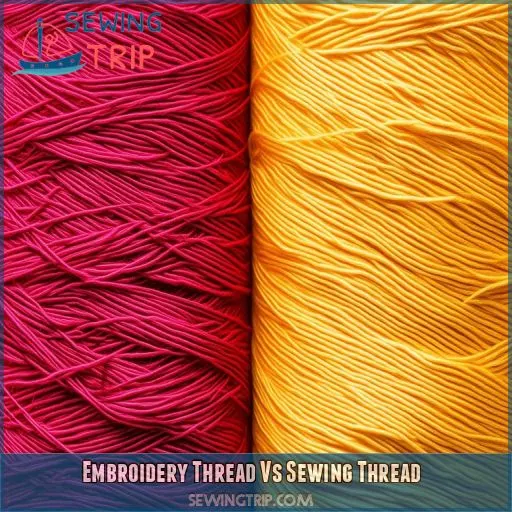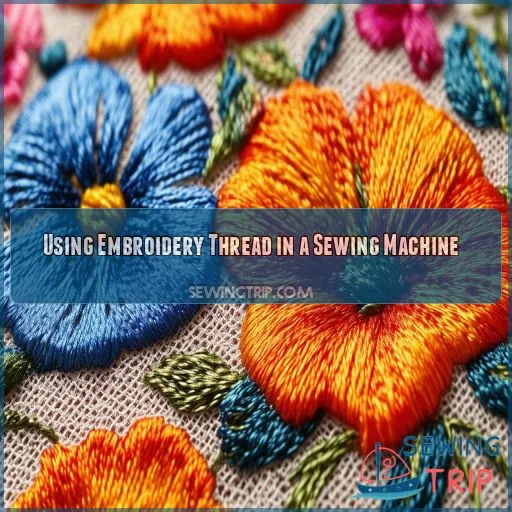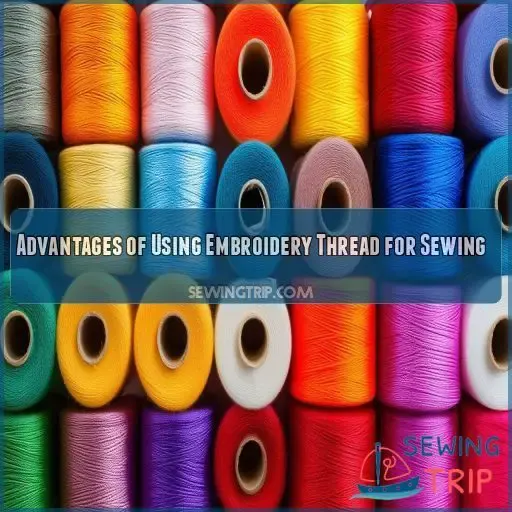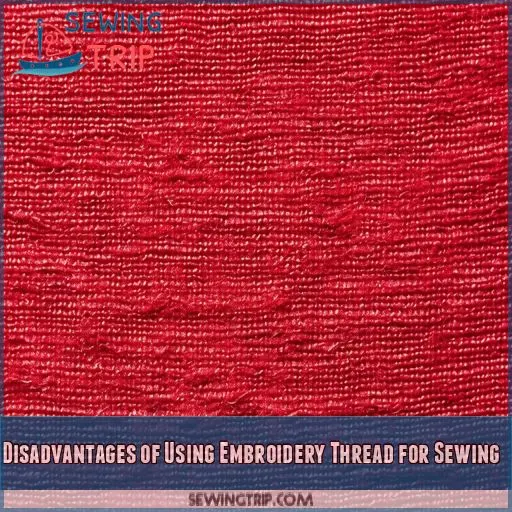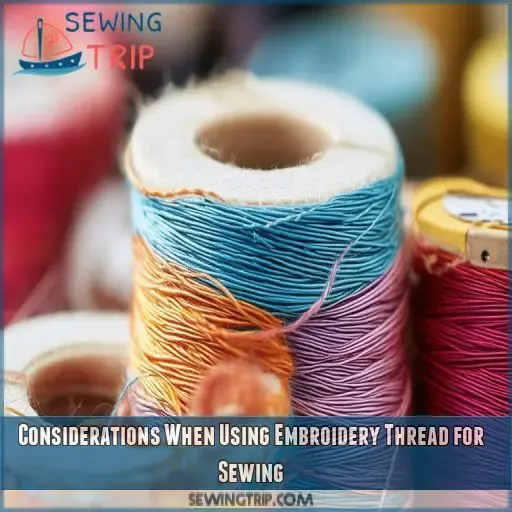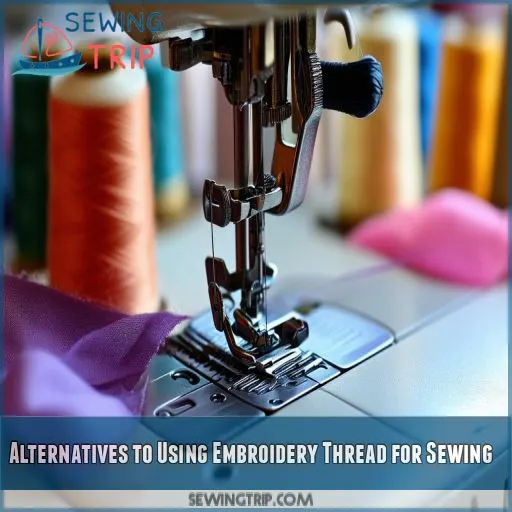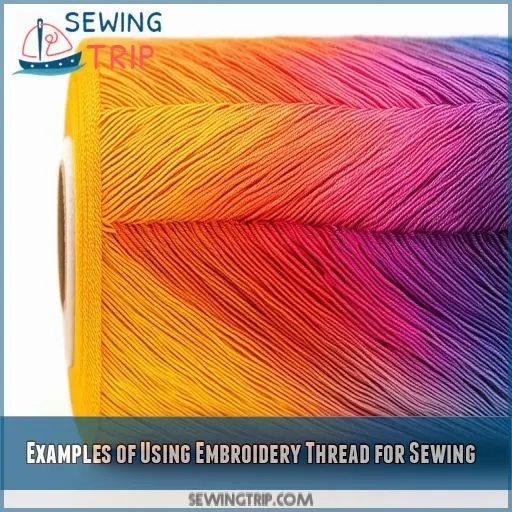This site is supported by our readers. We may earn a commission, at no cost to you, if you purchase through links.
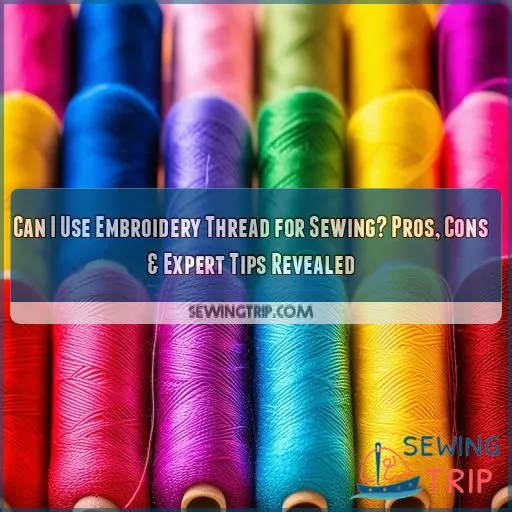 Yes, you can use embroidery thread for sewing, but it’s not always the best choice. While it adds shine and works well for decorative stitching on sheer fabrics, there are drawbacks.
Yes, you can use embroidery thread for sewing, but it’s not always the best choice. While it adds shine and works well for decorative stitching on sheer fabrics, there are drawbacks.
Embroidery thread is thicker and requires larger needles and higher tension in your machine. It’s also more expensive and less durable than regular thread, making it unsuitable for garments that’ll see a lot of wear and tear.
If you decide to use it, test on scrap fabric first, adjust your machine settings, and consider the project’s needs. For everyday sewing, stick to regular thread.
But for that extra pizzazz? Embroidery thread might just be your secret weapon. Let’s explore when and how to use it effectively.
Table Of Contents
- Key Takeaways
- Can I Use Embroidery Thread for Sewing?
- Embroidery Thread Vs Sewing Thread
- Using Embroidery Thread in a Sewing Machine
- Advantages of Using Embroidery Thread for Sewing
- Disadvantages of Using Embroidery Thread for Sewing
- Considerations When Using Embroidery Thread for Sewing
- Alternatives to Using Embroidery Thread for Sewing
- Examples of Using Embroidery Thread for Sewing
- Frequently Asked Questions (FAQs)
- Conclusion
Key Takeaways
- Embroidery thread can add some serious sparkle to your sewing projects, but it’s not always the best thread for the job. Think of it as the glittery eyeshadow of the sewing world – great for special occasions, not so much for everyday wear.
- When using embroidery thread in your sewing machine, you’ll need to make some adjustments. It’s like switching from a compact car to a monster truck – you’ve got to recalibrate everything from needle size to tension settings.
- While embroidery thread shines (literally) in decorative applications, it’s not the heavyweight champion when it comes to durability. Using it for high-stress areas is like wearing stilettos to a marathon – looks great, but probably won’t go the distance.
- If you’re itching to use embroidery thread but worried about its limitations, consider using it for embellishments only. It’s like adding a fancy bow tie to a plain shirt – you get the pizzazz without compromising on practicality.
Can I Use Embroidery Thread for Sewing?
Yes, you can use embroidery thread for sewing, but it’s not always the best choice. Embroidery thread is thicker and more decorative than regular sewing thread, making it suitable for certain projects like topstitching or embellishments, but it may not be ideal for everyday garment construction or items that will undergo a lot of stress.
Embroidery Thread Vs Sewing Thread
You’ll notice a significant difference in thickness and weight when comparing embroidery thread to sewing thread. Embroidery thread is typically thicker and heavier, designed for decorative stitching, while sewing thread is thinner and lighter, made for constructing garments and withstanding everyday wear and tear.
Differences in Thickness and Weight
When you’re comparing embroidery thread to sewing thread, you’ll notice significant differences in thickness and weight. These variations can impact your stitch quality and fabric texture.
Thread weight plays a key role in determining how your project turns out. Different thread brands offer various options, from lightweight cotton embroidery thread to heavier alternatives.
Understanding these distinctions is essential to choosing the right thread for your sewing machine and achieving the desired results in your projects.
Embroidery Thread is Thicker and Heavier
You’ll notice that embroidery thread is substantially thicker and heavier than regular sewing thread. This bulkier nature affects how it behaves in your machine.
You’ll need to adjust your needle size and thread tension to accommodate its heft. While this thickness can create beautiful, eye-catching stitches, it may impact seam strength.
Sewing Thread is Thinner and Lighter
You’ll notice sewing thread is much thinner and lighter than its embroidery counterpart. This slender profile allows it to glide through cotton fabrics with ease, using smaller needle sizes.
Whether you’re working with polyester, cotton, or rayon thread, it’s designed for everyday garment construction.
While embroidery thread shines in decorative applications, sewing thread’s strength and versatility make it the go-to choice for most stitching tasks. It’s the workhorse of your sewing kit!
Using Embroidery Thread in a Sewing Machine
When using embroidery thread in your sewing machine, you’ll need to make some adjustments for ideal results. Pay attention to needle selection, tension settings, sewing speed, thread organization, and always test on scrap fabric before starting your project.
Needle Selection
When using embroidery thread for sewing, opt for "embroidery" or "topstitching" needles. These have larger eyes, making threading easier. Choose a needle that can handle the thicker thread. Remember, proper needle selection is essential for achieving smooth stitches and preventing thread breakage.
Tension Adjustment
When using embroidery thread, you’ll need to adjust your machine’s tension. It’s different from regular thread, so experiment until you find the ideal setting. Test on waste cloth to guarantee proper stitch quality. Remember, thread strength and decorative effects depend on correct tension.
Sewing Speed
After adjusting tension, consider your sewing speed. Embroidery thread’s thickness affects machine performance. For desirable results:
- Slow down your pace
- Monitor stitch quality closely
- Adapt speed based on fabric compatibility
This approach ensures smooth stitching and prevents thread breakage or tension issues.
Thread Organization
As you slow down for embroidery thread, keep your spools organized. Use a wire stand or storage solutions to prevent tangles. Proper thread management guarantees smooth sewing and helps you switch between colors effortlessly, whether you’re doing machine embroidery or hand stitching.
Testing Before Use
After organizing your thread, it’s essential to test embroidery floss before embarking on your project. Here’s a quick checklist:
- Use scrap fabric
- Adjust tension settings
- Try different stitch lengths
- Check for thread breakage or skipped stitches
This guarantees a smooth journey on your embroidery thread adventure.
Advantages of Using Embroidery Thread for Sewing
You’ll find that embroidery thread can add a beautiful shine and luster to your stitches, making it ideal for decorative elements like topstitching, coverstitching, and buttonholes. It’s also an excellent choice for working with sheer or semi-sheer fabrics, as its thicker texture can create visually appealing accents without overwhelming delicate materials.
Adds Shine and Luster to Stitches
You’ve mastered threading your machine with embroidery thread, now let’s explore its dazzling potential. This specialized thread adds an alluring shine and luster to your stitches, transforming ordinary seams into eye-catching decorative accents.
Whether you’re working with sheer fabrics or creating vibrant buttonholes, embroidery thread – including metallic and silk varieties – offers a rainbow of colors to elevate your project.
It’s like adding a touch of magic to every stitch you make.
Can Be Used for Topstitching, Coverstitching, and Buttonholes
You’ve seen how embroidery thread adds shine, but it’s also versatile for decorative stitching. Use it for:
- Topstitching with contrasting colors for eye-catching details
- Coverstitching to create professional-looking hems
- Buttonholes that pop with added flair
For special occasions or heirloom sewing, embroidery thread elevates your projects. When gift-making, consider using SimThread or 40 wt polyester embroidery thread for superior tensile strength. Remember, bobbin thread choice matters too – pair it wisely for best results.
Suitable for Sheer or Semi-sheer Fabrics
When working with sheer or semi-sheer fabrics, embroidery thread can be your secret weapon. Its fine texture and lustrous appearance complement delicate materials beautifully.
You’ll find it excels in topstitching, coverstitching, and creating buttonholes on these light fabrics. For a matte look, opt for rayon embroidery thread.
Disadvantages of Using Embroidery Thread for Sewing
While embroidery thread can add visual appeal to your sewing projects, it comes with several drawbacks. You’ll find that it’s more expensive and less durable than regular thread, making it unsuitable for high-stress garments and requiring extra care to prevent shredding, especially with rayon varieties.
More Expensive Than Regular Thread
You’ll find embroidery thread costlier than regular sewing thread, impacting your budget for:
- Colorful quilting projects
- Intricate machine quilting designs
- Fabric-matching challenges
- Nylon or wool thread alternatives
- Specialized care requirements
Despite the expense, its unique properties often justify the investment for specific applications.
Not as Strong as Regular Thread
You’ll find embroidery thread isn’t as robust as regular sewing thread. While it’s great for decorative embroidery work, it lacks the tensile strength needed for construction seams. Rayon thread, in particular, can be delicate and prone to breakage under stress.
Not Suitable for Garments That Will Receive Stress
While embroidery thread lacks the strength of regular thread, it’s also not ideal for high-stress areas. You’ll want to steer clear of using it in garments that face constant wear and tear. Here’s where you should avoid it:
- Jeans seams
- Waistbands
- Armholes
- Active wear
Requires Extra Gentle Care
When using embroidery thread for sewing, you’ll need to handle your garments with extra care. Rayon and polyester threads are delicate, so avoid rough handling or harsh washing. For topstitching and coverstitching, treat your creations gently to maintain their beautiful appearance.
Can Shred Easily (rayon)
Rayon embroidery thread can shred easily, especially on delicate fabrics. You’ll need to handle it with extra care to prevent fraying. Here’s why it’s prone to shredding:
- Weaker fiber structure
- Sensitivity to friction
- Vulnerability to moisture
Keep this in mind when sewing with rayon thread.
Considerations When Using Embroidery Thread for Sewing
When using embroidery thread for sewing, you’ll need to take several precautions to attain successful results. Test seams on scrap fabric, use a smaller stitch length with a finer needle, and opt for polyester thread for strength, especially in high-stress areas like waistbands and hips.
Test Seams Before Constructing Entire Garment
Before embarking on your project, test embroidery thread on scrap fabric. You’ll get a feel for how it behaves in your machine and on your chosen material. This important step helps prevent headaches later, especially when considering waistband and hip strain.
Use Smaller Stitch Length and Finer Needle
After testing seams, adjust your machine for embroidery thread success. Use a smaller stitch length to prevent puckering and improve seam durability. Opt for a finer needle that’s compatible with your thread’s weight. This combo ensures smoother stitching and reduces fabric damage.
Consider Waistband and Hip Strain
When using embroidery thread, consider the strain on waistbands and hips. These areas endure constant stress, which can cause rayon threads to shred. Opt for extra gentle care and think twice before using embroidery thread in high-tension zones of your garments.
Use Polyester Thread for Strength
When strength matters, opt for polyester embroidery thread. It outperforms rayon in durability and overall performance. You’ll get the best of both worlds: the decorative appeal of embroidery thread and the robustness needed for garments that demand a bit more resilience.
Avoid Using for Garments With Heavy Activity or Stress
While polyester embroidery thread offers strength, it’s still not ideal for garments facing heavy stress. You’ll want to avoid using it on active wear or areas that take a beating. Stick to regular thread for high-stress seams to guarantee durability.
Alternatives to Using Embroidery Thread for Sewing
If you’re hesitant about using embroidery thread for sewing, consider some practical alternatives. You can buy a cheap or used machine for regular thread, test regular thread for color matching, use embroidery thread solely for embellishments, or opt for hand-stitching with embroidery thread for delicate finishes.
Buy a Cheap or Used Machine for Regular Thread
If you’re hesitant about using embroidery thread for regular sewing, consider buying a cheap or used machine specifically for standard thread. This way, you’ll have the flexibility to switch between machines for different projects. It’s a practical solution that allows you to enjoy the best of both worlds.
Test Regular Thread for Color Match
Instead of buying a new machine, you can test regular thread for color matching. It’s often easier to find and more budget-friendly. Consider these factors:
- Availability of thread colors in your area
- Thread weight compatibility with your fabric
- Fabric type and its interaction with regular thread
- Seam strength requirements for your project
Use Embroidery Thread for Embellishment Only
If color matching proves challenging, consider using embroidery thread solely for embellishments. This approach lets you enjoy its vibrant hues and sheen while avoiding potential construction issues. Here’s a quick guide to using embroidery thread for decorative purposes:
| Technique | Best Uses | Tips |
|---|---|---|
| Topstitching | Visible seams | Use lighter tension |
| Appliqué | Fabric attachments | Choose contrasting colors |
| Buttonholes | Decorative closure | Test on scrap fabric |
| Monogramming | Personalization | Slow machine speed |
| Decorative stitches | Pattern enhancement | Select appropriate stitch |
Consider Hand-stitching With Embroidery Thread for Delicate Finishes
When machine sewing isn’t suitable, consider hand-stitching with embroidery thread for delicate finishes. This technique allows for precise control and intricate decorative embellishments. You’ll create stunning hand-sewn accents that elevate your project. It’s perfect for adding that extra touch of elegance to hems, necklines, or cuffs.
Examples of Using Embroidery Thread for Sewing
You can use polyester embroidery thread for topstitching Tencel skirts, achieving a polished look with added shine. Commercial embroidery machines often use strong polyester thread, and you’ll find embroidery thread suitable for decorative applications like table runner bindings.
Tencel Skirts Can Be Topstitched With Polyester Embroidery Thread
You’ll find that polyester embroidery thread is a great choice for topstitching Tencel skirts. It offers excellent color matching options and adds a subtle sheen to your garment.
When using this thread, adjust your tension settings carefully and choose the right needle size.
Always test on scrap fabric to guarantee proper fabric compatibility and stitch quality.
Commercial Embroidery Machines Use Strong Polyester Thread
While Tencel skirts benefit from polyester embroidery thread, commercial machines take it a step further. They rely on strong polyester embroidery thread for a reason.
It’s durable enough to withstand high-speed stitching and frequent use. You’ll find this thread in decorative applications on mass-produced items like logo shirts and intricate designs on bags.
The strength of polyester embroidery thread makes it a go-to choice for professional-grade work.
Embroidery Thread Can Be Used for Table Runner Bindings
While commercial embroidery machines use strong polyester thread, you can also put embroidery thread to work on your home projects. Table runner bindings are a perfect example.
You’ll find that embroidery thread adds a decorative touch to these household items. Its sheen and color variety make it ideal for enhancing the edges of your table runners.
Even if you’re using an overlocker, embroidery thread can create stunning, durable bindings that’ll make your table runners stand out.
Frequently Asked Questions (FAQs)
Can embroidery thread be used for sewing Beyond embroidery?
While 90% of sewers use embroidery thread solely for decorative purposes, you can use it for sewing beyond embroidery. It’s great for topstitching, buttonholes, and sheer fabrics. However, it’s not ideal for stress-bearing seams or heavy-duty garments.
Can you use sewing thread in a sewing machine?
You can definitely use sewing thread in a sewing machine. It’s the standard choice for most projects. Just make sure you’re using the right type and weight of thread for your fabric and machine settings.
What threads are used for embroidery?
You’ll find various threads used for embroidery, including rayon, polyester, cotton, and silk. They’re designed for decorative stitching, offering vibrant colors and sheen. Choose based on your project’s needs, considering factors like durability, shine, and fabric type.
Can you sew clothes with embroidery threads?
You can sew clothes with embroidery threads, but it’s not ideal. They’re less durable and can shred easily. For best results, use embroidery thread for decorative stitching and regular thread for construction seams. Test on scrap fabric first.
Why is embroidery thread a good choice for a sewing machine?
Picture a vibrant rainbow flowing through your sewing machine. Embroidery thread‘s brilliant colors and lustrous sheen can elevate your projects. It’s perfect for decorative stitching, adding shine, and matching tricky fabric hues. You’ll love the eye-catching results!
Can you use regular thread on an embroidery machine?
You can use regular thread in an embroidery machine, but it’s not ideal. It’ll affect stitch quality and may damage your machine. For best results, stick to embroidery thread designed for the intricate patterns and high-speed stitching of embroidery machines.
Can embroidery thread be used for hand sewing?
Ever wondered about hand sewing with embroidery thread? You can, but it’s not ideal for most projects. It’s delicate and prone to breakage. For decorative stitching, though, it’s perfect. Consider using regular sewing thread for stronger, long-lasting seams.
How does embroidery thread affect fabric drape?
You’ll notice embroidery thread has a notable impact on fabric drape. It’s heavier and stiffer than regular thread, potentially making your garment less fluid. Consider using it judiciously or for decorative purposes to preserve the fabric’s natural flow.
Is embroidery thread suitable for outdoor or weatherproof projects?
Imagine: your outdoor project, exposed to the elements. Embroidery thread, while aesthetically pleasing, isn’t the ideal choice. It lacks weather resistance and can degrade rapidly. Consider using UV-resistant, waterproof threads specifically designed for outdoor use.
Can embroidery thread be used for invisible mending?
You can use embroidery thread for invisible mending, but it’s not ideal. It’s thicker and shinier than regular thread, making it more noticeable. For truly invisible repairs, stick with fine, matching sewing thread instead.
Does embroidery thread work well for basting stitches?
Basting’s best buddy, embroidery thread, can certainly serve for temporary stitching. You’ll find it’s easily removable and visible, making it ideal for quick fitting or pattern placement. However, it’s pricier than standard basting thread, so consider your project’s needs.
Conclusion
Deciding whether to use embroidery thread for sewing depends on your project’s particular purposes. While it can add pizzazz to your pieces, it’s not always practical. Consider the pros and cons carefully before choosing.
Ultimately, the question "Can I use embroidery thread for sewing?" has no one-size-fits-all answer. It’s about finding the right balance between aesthetics and functionality for your unique creations.

